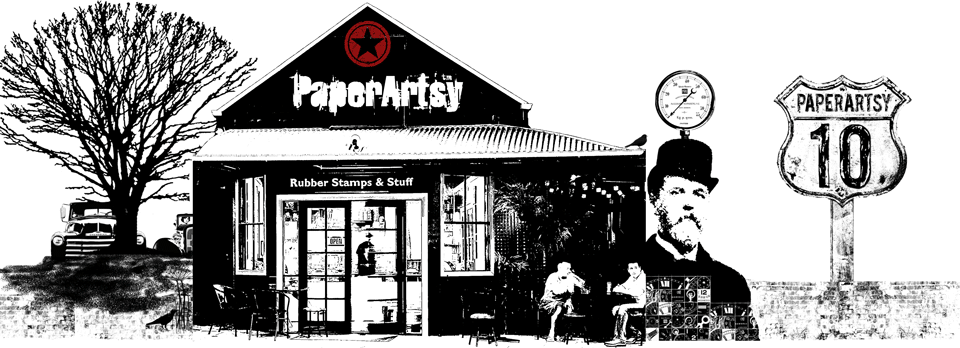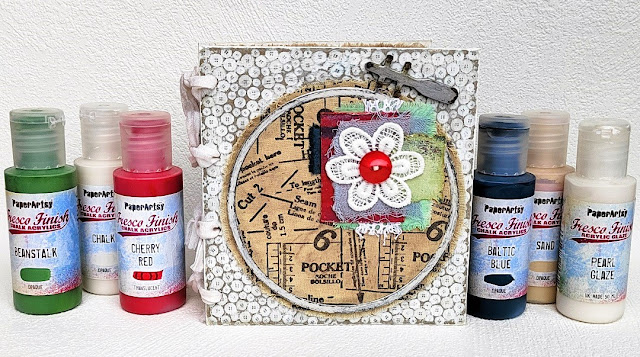Hi everyone, Jenny Marples here with you today. I've been a fan of the work of Roxanne Evans Stout for many years now, enjoying the way she creates collage art pieces with multiple mediums and textures. So I decided to try out her methods for this post. I started with a sewing themed stamp set, a die cut embroidery hoop and a rough idea to create some kind of collage journal and let everything evolve from there.
The finished journal has a vintage feel to it and the collage pages inside are my own small tribute to Roxanne's art. I also used stuck to using one stamp set throughout, looking to use the images in different ways on multiple surfaces for a coordinated look.
For this journal my starting point was a PaperArtsy Vintage Ink And The Dog stamp set ID03. It was the button corner image that got me thinking about using it to 'frame' an embroidery frame. The choice of mainly primary colours came to me by chance - a beautiful quilt on the TV featured them together and that became the inspiration for the whole project. I'm also head over heels in love with using Just Walnut Infusions to add vintage looking stains to pretty much anything!
PaperArtsy Infusions were the starting point for me; I love to make up batches of dyed fabric scraps with different powder combinations. Try using hot water to dilute them in an old ceramic mug and leave your bits of calico, linen, lace, ribbon etc to soak in the liquid for at least a day. There will be wonderful imperfections in the finished pieces and if you are planning on stamping onto them I would recommend ironing them first.
For this piece a little Lemoncello Infusions was added to the Just Walnut Infusions to add some warmth and tone down the pinkish shades it produces.
Mark in pencil the area you want covered with stamping and use a permanent ink, testing first to make sure it doesn't bleed and blur the images. You can see here how multiple stamping quickly covered the circle on my fabric.
Things took a few turns at this stage which is why the colours shown being used on my journal covers didn't make it to the final supplies list! The important bit is to notice how I used a fine gold embossing powder with the button stamp to achieve a raised pattern on which to sit the die cut embroidery frame (one from Eileen Hull Designs). Stick to using the Chalk PaperArtsy Fresco Finish Acrylic Paint to give the covers a base coat.
Another twist here which will show how you should never give up on your art! I had the bright idea to use a dark dilute colour to contrast with the frame and fabric. In theory this will work, though it would be easier to use the new PaperArtsy Mattints to achieve it.
As I began to assemble the pages the dark colour on the covers felt wrong so I applied a couple of coats of white gesso and sanded back the embossed areas to produce this paler, worn finish. It contrasts with the stained fabric without overpowering it and proves that anything can be salvaged!
As a finishing touch, and with a nod to the whole 'glazed' theme, I highlighted some of the stamped buttons with some PaperArtsy Pearl Glaze which catches the light and contrasts beautifully with the rest of the matte surface.
Now on to those pages...
Having shown in previous posts how I use a range of papers to make basic backgrounds I'm concentrating this time on the next layers. I like to create bases for my focal points with pieces of tissue paper that cover at least a third of each page. Old dressmaking patterns are great for this and I also rely heavily on a gel plate for creating painted scraps with torn edges.
Here you'll see how the gel printed tissues have been used to anchor and frame each collage cluster on the finished pages.
I mentioned at the start how the colours in a quilt inspired the paint selection for this project. In an attempt at being organised I store leftover papers, fabrics and trimmings in colour order, meaning I can more easily reach for bits that work with the chosen paints. If you are just starting out on your creative journey and need to build up a stash I would recommend going for the darker colours in the PaperArtsy sets, mixing them with a pale neutral like Chalk to create lighter shades as required. There is now a wealth of help available with colour mixing on the sidebar of this blog.
My 'primaries' selection of PaperArtsy Fresco Finish Chalk Acrylic Paints included Baltic Blue, Beanstalk, Cherry Red, Sand and Chalk.
Below you can see how the Cherry Red colour has been made less vibrant with the addition of a layer of Chalk behind it. This becomes a good base on which to stamp the tailor panel. Use the Baltic Blue with the Chalk to pull a paler blue gel print background and to highlight the letter tags at the bottom of the image. And finally mix the Beanstalk with the Chalk and dilute heavily to colour some torn fabric.
Returning to my original source of inspiration, in her books and online classes Roxanne shows how she has fun building clusters of different papers, fabrics and found objects on the way to creating her art.
I followed her methods, adding stamping and sheer netting to my page and bundling trims together to sit behind the focal point.
You can see from the finished page how each layer adds to the overall look of the finished page.
The Cherry Red painted fabric for my little Needle Book was enhanced with some stamping (using the Chalk paint) and a blanket stitched edge.
It opens to reveal more fabric scraps and a beaded pin.
The words from the stamp set were used throughout the journal, becoming their own cluster focal points.
By making each cluster before adding them to the backgrounds I could work out how best to place them to create a flow throughout the journal.
And before I knew it a set of pages had become a completed book.
I hope this did Roxanne's art methods justice and that you feel inspired to give it a go too. Play with your paints, pull lots of prints with your gel plate, dig out your leftovers and supplies (including the 'non-crafty' ones) and most importantly have fun making up your own clusters.
Jenny







































1 comment:
So beautiful ❤️ and the colours used are so cheerful and put together lovely xx
Post a Comment